Chiloscyllium plagiosum (Anonymous [Bennett], 1830)
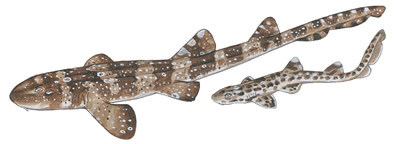 |
| Figure 1. Whitespotted bamboo shark and juvenile, Photo credit: The Shark Research Institute, Permission Pending |
1. Overview
Table of Contents
1.1 Description
Chiloscyllium plagiosum, which is more commonly known as whitespotted bamboo shark, is a small, mild reef-dwelling species1, which usually resides among rocks and coral reef regions across Indo-West Pacific Ocean2 . It is an active feeder on bony fish and crustaceans at night 3. Juveniles of this species have a distinctive pigmentation, which is slowly faded when they reach maturity. The adult size of this carpet shark can reach 95 cm. Whitespotted bamboo shark is a popular aquarium shark given its appealing look, relatively small size and high adaptability in captivity. As a result, it is a popular species in aquarium trades4.1.2 Relevance to Singapore
Singapore is one of the places that Chiloscyllium plagiosum has been observed in its natural habitat.The first record of this species was documented by J.W. Williams on 20 Sept in 1859, with observation of a bamboo shark with a total length of 317 mm within Singapore's water5. However, in recent years, sightings of whitespotted bamboo remain low in Singapore. Despite its high popularity as an aquarium fish, the biology and life history of this species in nature are poorly studied. This webpage provides a comprehensive overview about different perspectives of this species, for divers and intertidal lovers to understand the morphology of this shark better, in order to differentiate it from others species, and build up a better record of this species in Singapore.1.3 Interesting Facts
In 2002, it was reported that a female whitespotted bamboo shark hatched eggs despite without interacting with male bamboo sharks for more than 6 years. This is the first case that documents and provides evidence of parthenogenesis in this species. This finding was later verified in an parthenogenesis research study, indicating that female sharks have the ability to produce offspring via parthenogenesis. Such rare but possible spontaneous parthenogenesis processes have existing records in all vertebrates other than mammals6.
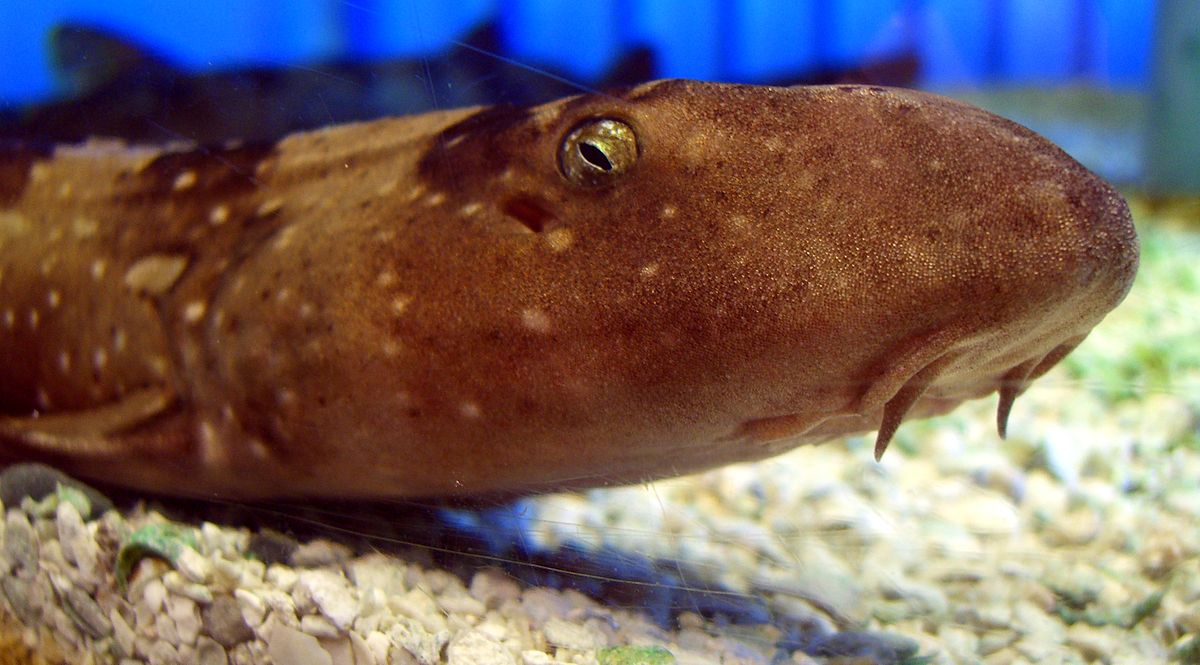 |
| Figure 2. Chiloscyllium plagiosum, Photo from WikiMedia Commons Credit: walknboston |
In 2000, three whitespotted bamboo sharks were hatched at Sea World in Orlando, Florida (US), marked the first record of albinism in the hemiscylliidae family. These sharks were diagnosed with albinism as they did not possess the usual brown and white pigments on their skins and lacked of black pigment in their eyes. However, albinism did not affect the growth of these sharks as compared to normal bamboo sharks from the same age group7.
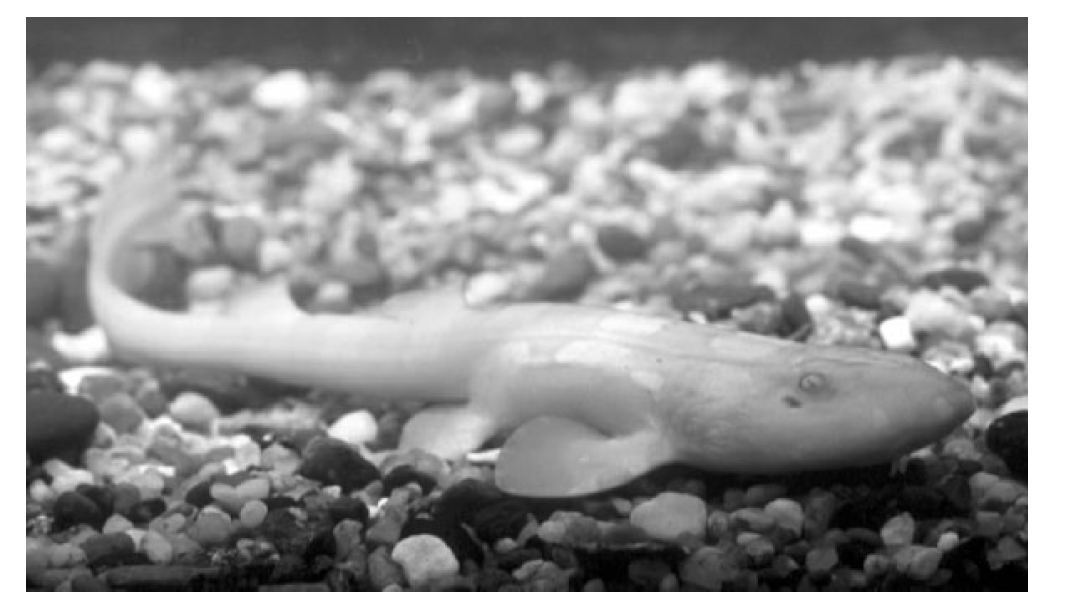 |
| Figure 3. Male, whitespotted bamboo shark, diagnosed with albino (Clark, 2002) Permission granted |
2. Conservation status and Commercial values
2. 1 Conservation Status
Chiloscyllium plagiosum was categorised under Near Threatened (NT) on the International Union for Conservation of Nature (IUCN) Red List in 2006. The current population in the wild remains unknown8. It faces threats such as destructive fishing, loss of habitat and climate change. Chiloscyllium plagiosum has a huge commercial value and is heavily hunted for human consumption, traded as aquarium fish and used as ingredient in traditional Chinese medicine.Whitespotted bamboo shark might face greater threat, given its growing importance in genetic research and popularity in commercial trade. The emerging potential in aquaculture might lessen the pressure on its current population. However, great attention should also be given to the conservation of wild whitespotted bamboo shark.
2.2 Fishery
Whitepspotted bamboo shark is known to be caught for human consumption in Taiwan. It is one of the species that has great catch volume in Taiwan. According to studies between 2002 and 2003, the price for this bamboo shark is about 8-10 US dollars/kilogram at Taiwan. However, trade volume for whitespotted bamboo shark is not clear as most of them are traded underground9.2.3 Aquarium trade and aquaculture
Whitespotted bamboo shark is a popular aquarium fish because of its appealing look, relatively small size and high adaptability in captivity. Such popularity has generated huge demand and trade value overtime. The demand from such trade also escalates hunting from the ocean. Fortunately, there is an emerging trend of bamboo shark aquaculture to bring back its population and prevent excessive hunting in the wild9. At Underwater World Singapore, they initiated the ornamental fish hatchery programme, which successfully produced whitespotted bamboo shark in the aquarium. In Manila, they also try to release the bamboo shark back to wild in the hope of increasing the population.2.4 Genetic Research
In the past 10 years, rapid development has been seem in the genetic research on this species10, research has found that certain miRNA from this species could help to prohibit the growth of liver cancer cells, and reduce the chances of breast cancer metastasis.3. Biology
3.1 Size
| Whitespotted Bamboo Shark |
Total Length (cm) |
|---|---|
| Longest record for female adult |
95 |
| Longest record for male adult |
83 |
| Common size of an adult bamboo shark |
60-80 |
| Length that will reach sexual maturity |
65 |
3.2 Colour
| Figure 4. Whitespotted Bamboo Shark, Photo Credit: Charles Tilford, annotation added by Lin Yuan |
Whitespotted bamboo shark has a unique colour pattern that is usually used to differentiate it from other species from the same genus. As suggested by its name, whitespotted bamboo shark has a brown body with 7-8 dark brown transverse bands, with numerous white colour dots scattered evenly on its skin11 . The white spotted colour pattern can help to differentiate this bamboo shark from other species under its family.
3.3 Unique Features
| Figure 5. Whitespotted Bamboo Shark, Photo from Wiki Media Common Public Domain, Labeled by Lin Yuan |
Its spiracles are present below the eyes . Several sensory barbels are present near its nostrils . Lateral ridge are observed on both sides of the trunk. It has two pelvic fins, which are of the same size as its dorsal fins. The first dorsal fin origin is directly opposite to pelvic fin. The pectoral fins are well developed and adaptable, allow them to glide near the benthic floor. The anal fin is position right in front of the caudal fin. The elongated precaudal tail is much longer than total length of the trunk and head2.
3.4 Diagnostic Features
Here are the morphological comparison of Chiloscyllium plagiosum with two other species from the same genus and are also native to Singapore, which are Chiloscyllium plagiosum and Chiloscyllium punctatum2.| Name |
Photo |
Diagnostic Features |
|---|---|---|
| Chiloscyllium indicum |
 |
1.Body and tail very slender 2.Anal fin is quite a distance away from the second dorsal fin 3.The length of anal fin length is similar to the length of hypural caudal lobe |
| Chiloscyllium plagiosum |
 |
1.Body and tail moderately slender 2.Anal fin is just below the second dorsal fin 3.length of anal fin is much short than that of the hypural caudal lobe |
| Chiloscyllium punctatum |
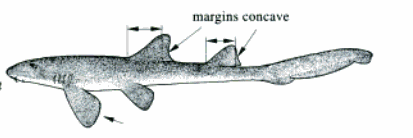 |
Second dorsal fin has a longer length than the first dorsal fin |
3.5 Reproduction
During courtship, the male shark will bite the pectoral fin of the female during swimming for about half an hour and the mating duration is about five minutes. There is evidence that female bamboo sharks are able to store sperms over a period of time as the female bamboo shark can lay eggs 2-3 months after mating12. It is oviparous. During the ovulation period, one female bamboo shark can lay 15-20 eggs. These eggs are about 10-13 cm long and hatching duration is about 4-5 months9.
Here is the embryo development captured during the hatching process.
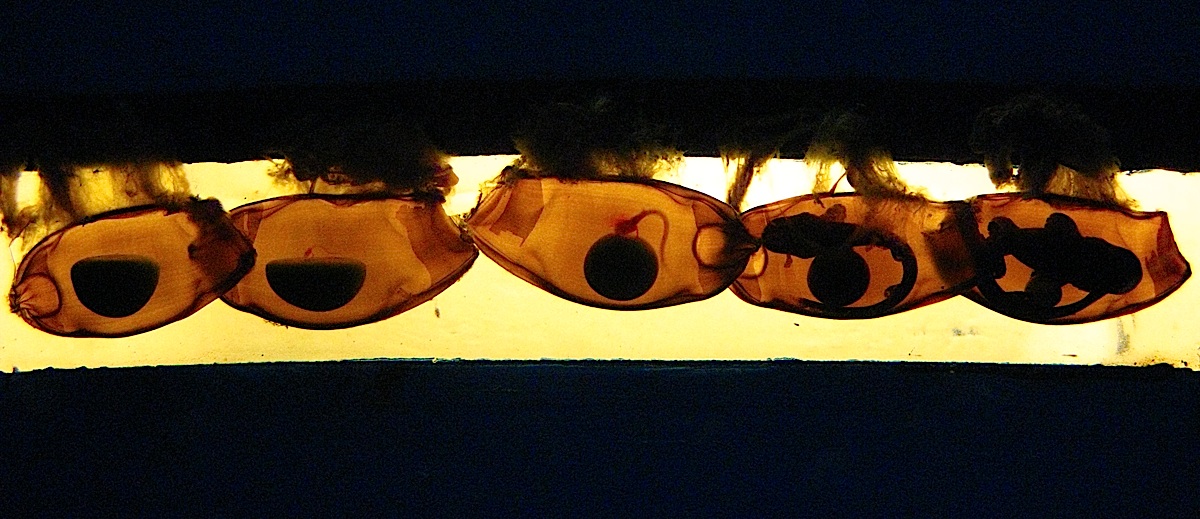 |
| Figure 6. Embryo Development Photo Credit: Hilda, Pending Permission |
3.6 Morphology and behaviour
It is a reef dwelling bamboo shark that lives near the benthic floor that is closer to shore. It is nocturnal and prey on small fish at night1.
This video shows the slow movement of a whitespotted bamboo shark sliding along the bottom of the tank.
.
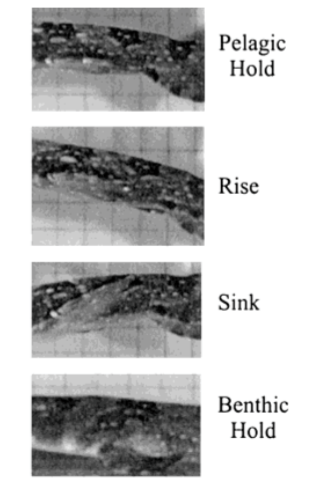 |
| Figure 7. "Functional morphology of the pectoral fins", photo from Wilga & Lauder, Pending Permission |
Study shows that the pectoral fins of this bamboo shark have significantly different body angles in different kinds of movement13, to allow the shark to stay at both the benthic and pelagic zones in the ocean and move up and down easily.
The teeth of this species are capable of holding prey with soft tissue and biting hard-bodied prey. The presence of the clutching type tooth morphology enables it to grab soft prey. Its dental arrangement and jaw joint help the bamboo shark to catch hard-bodied prey14. Such morphology of the teeth also plays a part in determining the diet of this species, enables it to have a wider range of choices.
4. Distribution
4.1 Natural Habitat
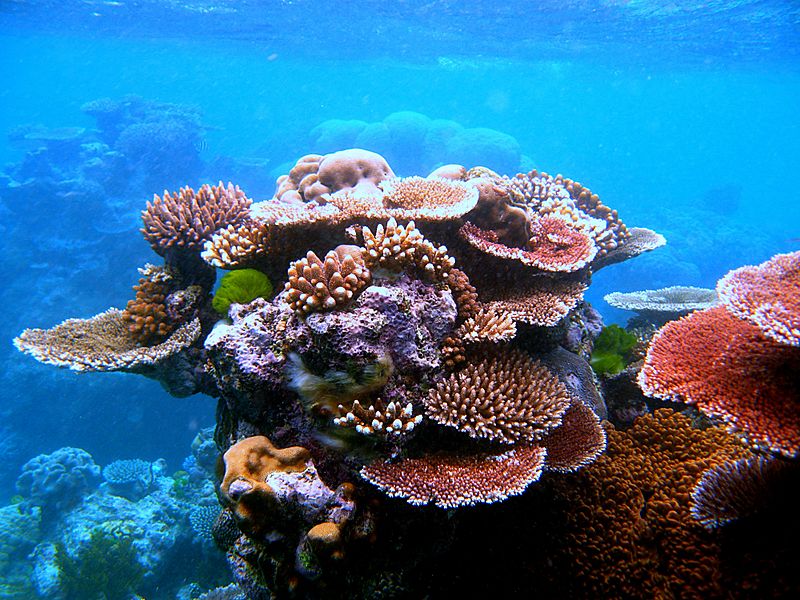 |
| Figure 8. Natural Habitat for whitespotted bamboo shark, photo from WikiMedia Common, Credit: Toby Hudson |
4.2 Geographical location and distribution
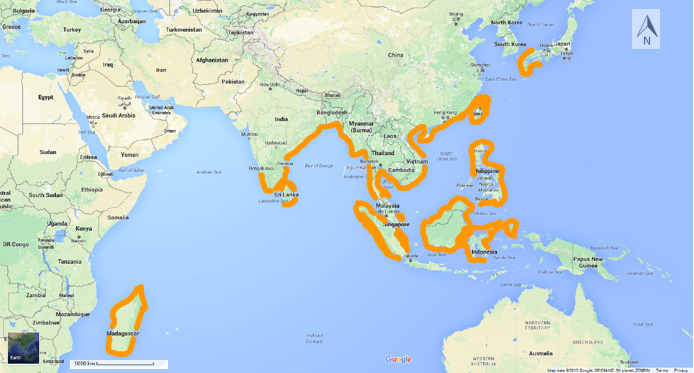 |
| Figure. 9 Geographical distribution, photo from Google map, edited by Lin Yuan |
It could be found in the Indo-West Pacific region and has been observed along the coasts of Cambodia, India, Indonesia, Malaysia, Singapore, South Korea, Taiwan, Vietnam, Thailand, China. Furthermore, countries such as Maldives, Papua New Guinea, Sri Lanka, Vietnam and Madagascar also have documented the presence of this species8.
5. Nomenclature
5.1 Common names
| English |
Bluespotted Bamboo Shark, Whitespotted Bamboo Shark |
|---|---|
| French |
Requin-chabot Á Taches Blanches, Requin-chabot À Taches Bleues |
| Spanish |
Bamboa Estrellada, Bamboa Punteada |
5.2 Synonyms
| Synonyms |
Source |
|---|---|
| Scyllium ornatum |
Gray, 1830 |
| Scyllium plagiosum |
interruptum Bleeker, 1852 |
| Chiloscyllium indicum |
margaritifera Günther, 1870 |
| Chiloscyllium caerulopunctatum |
Pellegrin, 1914 |
6. Taxonomy and phylogeny
6.1 Taxonomical Classification
| Phylum |
Chordata |
|---|---|
| Subphylum |
Vertebrata |
| Infraphylum |
Gnathostomata |
| Superclass |
Chondrichthyes |
| Class |
Chondrichthyes |
| Subclass |
Elasmobranchii |
| Superorder |
Euselachii |
| Order |
Orectolobiformes |
| Family |
Hemiscylliidae Gill, 1862 |
| Genus |
Chiloscyllium Müller and Henle, 1837 |
| Species |
Chiloscyllium plagiosum (Anonymous [Bennett], 1830) |
Whitespotted bamboo shark is one of the seven species classified and described under the genus Chiloscyllium. In 1837 Muller and Henle described the genus Chiloscyllium which included Scyllium plagiosum(which is now know as Chiloscyllium plagiosum)5.
6. 2 Phylogeny
In the past, the species delimitation within the genus Chiloscyllium was mainly based on morphologically differences such as colour, position of fins, and body to tail ratio. Such methods might not be sufficient to clearly explore the relationship between these species. With the help of molecular systematics, we could have additional tool and evidence for species delimitation16.
In the 18 centuries, there was a growing interest in species delimitation within the order elasmobranchs and Müller and Henle assigned the genus Chiloscyllium to bamboo sharks. Under this genus, there are currently 7 described species. However, insufficient phylogenetic studies have led to confusion of relationship among species within this genus. It is unclear that whether C. indicum or C. Punctatum is a sister taxon under other Chiloscyllium speices. Based on a study of using Maximum parsimony to analyse a part of the 12S rRNA gene sequences, it shows that whitespotted bamboo shark is more closely related to C. indium. C. punctatum is also closely related to both C. indicum and C. plagiosum16. However, the result indicates that neither C. indicum nor C. Punctatum is a sister taxon to all other Chiloscyllium species.
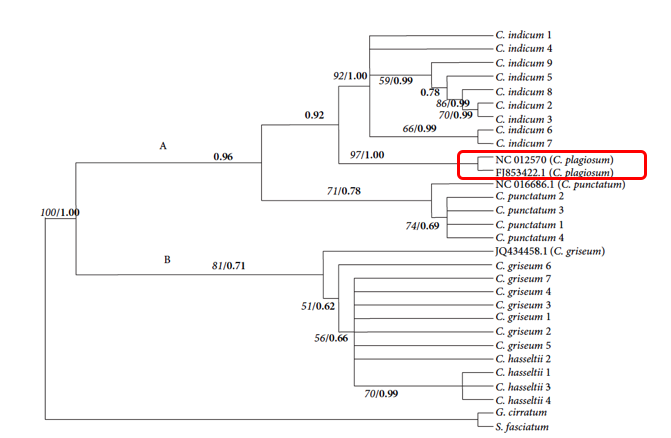 |
| Figure 10."Maximum parsimony cladogram of partial 12S rRNA gene sequences and Bayesian posterior probability tree. Italic numbers at the branches stand for bootstrap values higher than 50% of 1000 replications and bold numbers stand for Bayesian posterior probability value." |
(Source: Masstor, Samat, & Md-Zain, 2014, Creative Common)
6.3 Original Description and Type information
This species was first documented by Bennett 1830 as Scyllium plagiosum and was later renamed as Chiloscyllium plagiosum.
Holotype of Scyllium plagiosum (synonym) by Bennett in 1830 was kept in British Museum (Natural History) and its current status is probably lost.
Neotype was designated by Dingerkus and DeFino in 1983 in California Academy of Sciences, CAS-36046, it is a 503 mm TL adult male, and its locality is from Indonesia2.
7. Relevant links
1. The reproductive behaviour of whitespotted bamboo shark in natural environment is not well studied. Tony Wu, a naturalist has put in great effort to photograph the mating process of this species at Kanoura Japan. If you are interested in the courtship of this whitespotted bamboo shark, find more information in her blog. http://www.tonywublog.com/journal/whitespotted-bamboo-shark-mating-chiloscyllium-plagiosum/
2. Sightings of whitespotted bamboo shark in Singapore: http://lazy-lizard-tales.blogspot.sg/2012/06/surprise-catch-angler-hooks-baby-shark.html
3. Barcode of Life
4. Biodiversity Heritage Library
5. FAO Species fact sheets
8. Reference
[1] “Chiloscyllium plagiosum (Anonymous [Bennett], 1830) Whitespotted bambooshark” by fishbase. Org, 17 Nov 2015. URL: http://www.fishbase.org/summary/5120 (accessed on 18 Nov 2015).
[2] Compagno LJV. 2001. An annotated and illustrated catalogue of shark species known to date. In FAO species catalogue for fishery purposes, Sharks of the world. Rome: Food and Agricultural Organization, 1(2): 173-175.
[3] “WHITESPOTTED BAMBOOSHARK” by Ichthyology, 17 Nov 2015 URL: https://www.flmnh.ufl.edu/fish/Gallery/Descript/wsbambooshark/wsbambooshark.html
[4] Romero, P., 2002. An etymological dictionary of taxonomy. Madrid, unpublished.
[5] Dingerkus, G., & DeFino, T. C. 1983. A revision of the orectolobiform shark family Hemiscyllidae (Chondrichthyes, Selachii). Bulletin of the AMNH; v. 176, article 1.
[6] Feldheim, K. A., Chapman, D. D., Sweet, D., Fitzpatrick, S., Prodöhl, P. A., Shivji, M. S., & Snowden, B. 2010. Shark virgin birth produces multiple, viable offspring. Journal of Heredity, 101(3), 374-377.
[7] Clark, S. 2002. First report of albinism in the white‐spotted bamboo shark, Chiloscyllium plagiosum (Orectolobiformes: Hemiscyllidae), with a review of reported color aberrations in elasmobranchs. Zoo Biology, 21(6), 519-524.
[8] Kyne, P.M. & Burgess, G.H. 2006. Chiloscyllium plagiosum. The IUCN Red List of Threatened Species 2006: e.T60222A12325334.__http://dx.doi.org/10.2305/IUCN.UK.2006.RLTS.T60222A12325334.en__ . Downloaded on 11 November 2015.
[9] Chen, W. K., Chen, P. C., Liu, K. M., & Wang, S. B. 2007. Age and growth estimates of the whitespotted bamboo shark, Chiloscyllium plagiosum, in the northern waters of Taiwan. ZOOLOGICAL STUDIES-TAIPEI-, 46(1), 92
[10] Wang, Y., Xu, S., Su, Y., Ye, B., & Hua, Z. 2013. Molecular characterization and expression analysis of complement component C9 gene in the whitespotted bambooshark, Chiloscyllium plagiosum. Fish & shellfish immunology, 35(2), 599-606.
[11] "Species Fact Sheet" by FAO, URL: http://www.fao.org/fishery/species/11344/en (accessed on 18 Nov 2015)
[12] “Whitespotted Bamboo Shark Mating” by Tony Wu, 25 May Nov 2014. URL: http://www.tonywublog.com/journal/whitespotted-bamboo-shark-mating-chiloscyllium-plagiosum/(accessed on 18 Nov 2015).
[13] Wilga, C. D., & Lauder, G. V. 2001. Functional morphology of the pectoral fins in bamboo sharks, Chiloscyllium plagiosum: benthic vs. pelagic station-holding. Journal of Morphology, 249(3): 195-209.
[14] Ramsay, J. B., & Wilga, C. D. 2007. Morphology and mechanics of the teeth and jaws of white‐spotted bamboo sharks (Chiloscyllium plagiosum). Journal of Morphology, 268(8), 664-682.
[15] “Chiloscyllium plagiosum (Anonymous [Bennett], 1830)” Retrieved [17 Nov 2015], from the Integrated Taxonomic Information System (ITIS) (http://www.itis.gov).
[16] Masstor, N. H., Samat, A., Nor, S. M., & Md-Zain, B. M. 2014. Molecular Phylogeny of the Bamboo Sharks (Chiloscyllium spp.). BioMed research international, 2014.